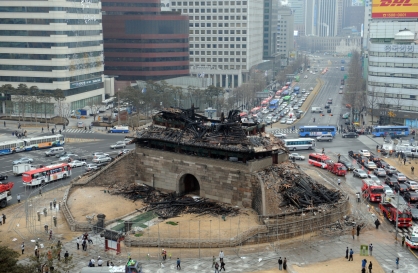Most Popular
Korean History
-
1
2014 ferry disaster left scars that never healed

-
2
In 2012, K-pop makes leap from 'Gangnam' to the world

-
3
Deadly sinking of Navy ship in 2010 marks worst postwar military disaster

-
4
In 2008, Korea's National Treasure No. 1 went down in flames

-
5
In 2005, science world’s biggest scandal unravels in Seoul

[Korean History] In 2003's Daegu, disaster plays out underground
Arson attack killed nearly 200 in the deadliest subway tragedy in South Korean history, leading to safety overhaul in metro systems
By Yoon Min-sikPublished : Oct. 11, 2023 - 16:40
Passengers traveling on the South Korean subway system may have encountered seats lacking fabric covering, resulting in a more slippery experience than expected.
Keen-eyed riders might have also noticed the presence of manual door handles, gas masks and flashlights inside the train or on the platforms.
These are part of the safety features of Korean metro system, introduced after a hard and painful lesson: the 2003 arson attack on a subway train in the southern city of Daegu.
“Subway arson attack kills 130,” reads the top story of the Feb. 19, 2003 edition of The Korea Herald, telling the harrowing tale of how a blaze turned the bustling underground city space into a nightmarish inferno, trapping many in flames and smoke.
Even the horrifyingly high initial casualty figures turned out to be wildly optimistic, as the final death toll came in at 192.
Three bodies were damaged beyond the ability to identify them via DNA, while the other three were never claimed by their kin. The incident remains to this day the deadliest single crime in the country’s history.
The Daegu tragedy was a wake-up call that touched off a mass-scale overhaul of safety procedures across the country’s metro networks, as the incident revealed severe disaster management protocol issues. While the disaster was sparked by the actions of one individual, the systematic lack of proper response measures led to the death toll being as high as it was.

Arsonist onboard
On Feb. 18, 2003, Daegu metro train no. 1079 pulled into Songhyeon Station at around 9:30 a.m. Among the passengers who boarded the train was 56-year-old Kim Dae-han.
He carried with him two liters of gasoline in a shampoo bottle and a lighter. Kim had been diagnosed with a level 2 mental disorder in 2001 resulting from a stroke that left him with a disability and unemployed. He had threatened to set fire to a psychiatric hospital just 10 days earlier.
About 20 minutes later, after the train had arrived at Jungangno Station, Kim lit the bottle on fire and threw it on the ground.
“Passengers around him tried to stop him, but he set fire (to the train) and ran away,” a 35-year-old woman surnamed Seok was quoted as saying in the article.
Three minutes later, train no. 1080 entered Jungangno Station from the opposite side and pulled forward on the track. “Proceed safely. There’s a fire at Jungangno Station,” was what the conductor was told.
By that time, the station had filled with dense smoke and power had been cut off.
Neither the conductor nor the metro control tower apprehended the severity of the situation. Neither did the passengers on train no. 1080.
Precious minutes passed as the conductor tried to communicate with the control center on what to do and restart the station's electricity with the emergency backup power generator, which did not work.
When he finally received instructions to evacuate passengers, the conductor left the train. He carried the master key as instructed, which sealed the fate of many passenger still inside the train.
Removing the master key shuts down nearly all of a subway's functions, including the opening and closing of the doors.
Trapped passengers made desperate calls to their loved ones before they succumbed to tragedy. One of them reported in local media proceeded as follows.
“Follow the other passengers to make your way out safely,” said a mother to her daughter onboard the train, to which the daughter responded, “Mom, but the door won’t open.”
By the time emergency workers had put out the fire at around half past 1 p.m., over 100 passengers had been killed in train no. 1080 alone.
Kim, the arsonist, was indicted on multiple charges of murder and arson and was sentenced to life imprisonment. The following year, while incarcerated, he suffered a stroke and died.
Nine employees of the Daegu Metropolitan Transit Corp. also faced consequences for their bungled response.
The conductor of the no. 1080 train, surnamed Choi, was the most severely punished among them, as over 70 percent of the deaths were from his train. He made the grave mistake of failing to evacuate passengers in a timely manner, telling them to stay still inside the train until further notice and failing to realize that people were locked in when he fled the vehicle with the master key. He had been instructed to do so, but he was nonetheless sentenced to five years of imprisonment for involuntary manslaughter.
Employees of the control center were also punished, as was the conductor of the no. 1079 train. Although he immediately rushed to the scene of the fire, attempted to extinguish it and made sure that his passengers were out of the train, he failed to report the fire to the control center.

Safety overhaul
The conductor of the ill-fated train no. 1080 later told local media he was unaware that a subway could catch fire as rapidly as it did, as he was taught that only inflammable materials were used in its construction.
Contrary to his belief, flammable materials were commonly used in subways at that time. As the fire spread rapidly, toxic gas engulfed the station, making escape -- and rescue efforts -- extremely challenging.
The Daegu Metropolitan Government in 2005 published a white paper on the tragedy, in which they pointed to the flammable materials as the reason the fire had spread so rapidly. The majority of the subway cars manufactured before 2004 used flammable materials such as polyurethane foam in seats to save costs.
By 2009, all subway cars using flammable materials were out of commission, a measure that proved to be effective in another arson attack in 2014 at Dogok Station in Seoul. A 71-year-old man poured paint thinner on the floor of a subway to start a fire, which was confined to a small space.
The Railway Safety Act was also revised to ban carrying “hazardous substances” that could start a fire -- a clause that did not exist in 2003. Starting in 2005, public facilities that house 100 people or more are mandated to install self-contained breathing apparatuses to use in cases of emergency.
Other measures included Daegu transit authorities installing 13,000 fire detectors across its 91 subway stations, and Seoul Metro placing an average of 220 gas masks in each station.
Another problem revealed by the Daegu metro tragedy was that most of the passengers did not know how to manually open the subway doors. The manual door levers on the post-Daegu subways are now larger and in brighter colors than before, accompanied by large instructions.
Twenty years have passed since the subway tragedy that shocked the nation, but surveys indicate that the survivors are still suffering as a result of the incident. Last year, the Daegu city government conducted a survey of 56 people who were injured in the Daegu fire.
It found that 50 of them still suffer from post-traumatic stress disorder, along with accompanying depression and insomnia. The damage was not confined to mental health issues either, as 33 of them said smoke inhalation from the fire left them with permanent breathing problems.
























![[Today’s K-pop] Treasure to publish magazine for debut anniversary](http://res.heraldm.com/phpwas/restmb_idxmake.php?idx=642&simg=/content/image/2024/07/26/20240726050551_0.jpg&u=)